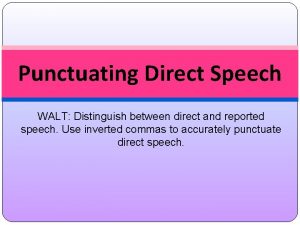Do Studies of Speech Sound Acquisition Accurately Represent


- Slides: 2

Do Studies of Speech Sound Acquisition Accurately Represent all Children? A Comparison of Demographic and Design Variables across Normative Studies Allyson Mertz & Amy Glaspey , Ph. D, CCC-SLP . Background Normative data have been collected from samples of the population in order to establish a developmental timeline of speech sound production. This timeline is used by speech-language pathologists (SLPs) to determine whether a child’s speech skills are developing in a typical or delayed manner, and is often critical in qualifying a child for speech pathology services. Purpose: This poster examines demographic and design variables used in normative studies to support increased validity in clinical decision-making. Significance: For the clinical comparison to be accurate and valid, SLPs should be aware of the demographic and design variables used in each study to determine if the child being tested is fairly represented. Methods Study Selection: Six studies of speech sound acquisition were selected for comparison: Glaspey (2019), Mc. Leod and Crowe (2018), Shriberg (1993) and Smit, Hand, Freilinger, Bernthal, and Bird (1990), Templin (1957), and Wellman (1931). These studies were selected based on the frequency of use or publication date. Frequency was determined with the website Dimensions, which gathers citation stats on each article. Variable Selection: 8 demographic variables and 4 design variables were compared. Demographic variables describe qualities of the participants. Design variables describe testing procedures. Demographic Variables Design Variables Sample Size: Number of children in the study Age Range: The ages of children in the study Consonants: Number of consonants recorded. Different languages have varying consonant sounds. SES Measure: A measure of the finances of child’s family, which may influence language acquisition Positions: Where the speech sound occurred within the word, which may influence ease of production Geographic Location: Where the study was conducted Picture or Word Stimuli: What materials prompted the children to say the target sound Census Used: Census the study used to match demographic info to the overall population of U. S. Spontaneous Speech or Repetition: Examines how the child produced the sound. Repetition is easier for Speech/Developmental Delays: Inclusion or exclusion of children with delays children than spontaneous speech. Some studies had protocol to scaffold the child to the sound. Race/Ethnicity: Extent the race or ethnicity of participants was described Results Wellman Templin (1931) (1957) Sample Size 204 children 480 children Age Range 2 to 6 yrs. 3 to 8 yrs. SES Measure Not recorded Father’s occupation Geographic University of 35 schools Location Iowa Minneapolis, preschool Minnesota Census Used Not recorded Yes- 1940 Speech Delay Not recorded Excluded Dev. Delay Not recorded Excluded Race or Not recorded White Ethnicity Smit et al. (1990) 1, 027 children 3 to 9 yrs. Parent’s education Schools across Iowa and Nebraska Yes- 1980 Included Excluded Not limited to one racial background Shriberg Mc. Leod and Glaspey (1993) Crowe (2018) (2019) 26, 007 children 880 children 64 children 3 to 6 yrs. 5 mos-12 yrs. 3 to 10 yrs. Not recorded Parent’s education Schools in 31 countries 88 sites in Madison, around the 37 states Wisconsin world. across U. S. Not recorded Yes- 2010 Included Not recorded Included Excluded Not recorded Included Not recorded Numerous Accounted for six categories Consonants Positions Wellman (1931) 26 consonants Initial, medial, and final Picture or Pictures Word Stimuli Templin (1957) 25 consonants Initial and final Preschool: Pictures Elementary: reading Spontaneous Mixed Speech or Repetition Smit et al. (1990) All consonants, except /ʒ, ð/ Initial and final Shriberg (1993) 24 consonants Pictures Not recorded Varied Across Pictures Studies Initial, medial, and final Mc. Leod and Glaspey Crowe (2018) (2019) Full consonant 24 repertoire of consonants each language 55 studies Initial and initial, 40 final studies medial, 42 studies final Both used in Not recorded 45 studies used Both used in repetition, 11 a cuing spontaneous hierarchy speech. Discussion Sample Size: Varied from 64 children to 26, 007 children Age range: Spanned from 2 to 12 years Consonants: The number of consonant sounds examined ranged from 24 -26. Positions: All studies looked at consonants in the initial and final positions, and three included SES Measure: Two studies used parent’s education the SES measure. Categories in these studies ranged consonants in the medial position. from less than high school to post grad. One study used father’s occupation. Three studies did not record. Picture or Word Stimuli: Three studies used picture stimuli. Templin used pictures or reading depending Geographic Location: Study locations varied from one city to 31 countries around the world. on the age of the child. Census Used: Three studies used census data. They used the 1940, 1980, and 2010 census. Spontaneous Speech or Repetition: One study solely recorded the spontaneous speech of children. One study did not record whether speech was spontaneous or repeated after clinician. The other studies Speech Delay: Two studies included, two studies excluded, two studies did not record. used a combination of spontaneous speech and repetition. Developmental Delay: One study included, three studies excluded, two studies did not record. Race/Ethnicity: One study limited participant’s race to white. Three studies did not record race/ethnicity Clinical Implications and Future Directions: SLPs need to be aware of differences in participant of participants. Glaspey (2019) recorded Caucasian, African American, Asian American, American Indian, demographics and study design because they influence the validity & applicability to children with speech sound disorders. Testing a child against a sample that is not representative of them may lead to or Two or more ethnicities. By nature Mc. Leod & Crowe (2018) included numerous ethnicities. misdiagnosis. SLPs should seek out normative data that matches the child they are testing. Future *See Attached Page for references. studies should aim to be more inclusive so that they can be accurately compared to a wider range of children.

References for “A Comparison of Demographic and Design Variables Across Normative Studies” Glaspey, A. M. (2019). The Glaspey Dynamic Assessment of Phonology. Academic Therapy Publications. Mc. Leod, S. , Crowe, K. (2018). Children's Consonant Acquisition in 27 Languages: A Cross-Linguistic Review. Journal of Speech and Hearing Disorders, 27(4), 1546 -1571 Sander, E. K. (1972). When are Speech Sounds Learned? Journal of Speech and Hearing Disorders, 37(1), 55– 63. Shriberg, L. D. (1993). Four New Speech and Prosody-Voice Measures for Genetics Research and Other Studies in Developmental Phonological Disorders. Journal of Speech and Hearing Research, 36(1), 105 -140 Smit, A. B. , Hand, L. , Freilinger, J. J. , Bernthal, J. E. , & Bird, A. (1990). The Iowa Articulation Norms Project and its Nebraska Replication. Journal of Speech and Hearing Disorders, 55(4), 779 -798 Templin, M. C. (1957). Certain language skills in children; Their development and interrelationships. US: University of Minnesota Press. Wellman, B. L. , Case, I. M. , Mengert, I. G. , & Bradbury, D. E. (1931). Speech sounds of young children. University of Iowa Studies: Child Welfare, 5(2), 82.



